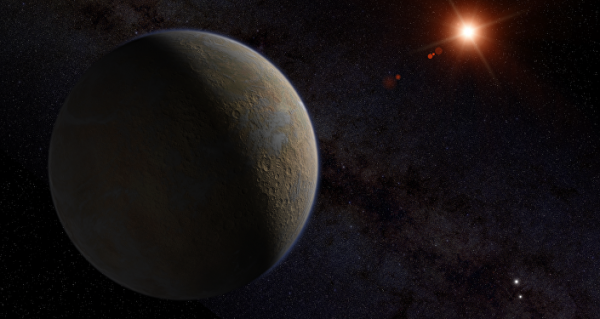
An enigmatic radio signal was registered recently, ostensibly from the direction of Proxima Centauri, a red dwarf star that is only 4.2 light-years from the Sun, sparking speculation that it could finally be a long-anticipated “calling card” from another civilisation.
An intriguing radio wave emission that is understood to have come from the vicinity of Proxima Centauri, the Sun’s nearest stellar neighbour, recently triggered a wave of speculation that this might be the much sought-after evidence of life in space.
The signal, picked up in late October 2020 by the Breakthrough Listen project, and dubbed BLC-1, for Breakthrough Listen Candidate-1, was unlike anything the project has previously encountered.
Breakthrough Listen uses software filters that shave off the cacophony of signals originating from Earth or Earth-orbiting satellites to isolate those hailing from deep space.
This transmission had “particular properties that caused it to pass many of our checks, and we cannot yet explain it”, team leader Andrew Siemion was quoted as saying by Scientific American.
Earlier, in April and May 2019, while observing Proxima Centauri, a red dwarf 4.25 light-years from Earth, the 64-metre Parkes radio telescope in Australia picked up a faint signal.
In late October 2020, Breakthrough Listen intern Shane Smith unearthed a narrowband transmission at a frequency of 982.002 megahertz in the data.
The signal apparently showed up during five 30-minute periods over several days as the telescope was pointing directly at Proxima. Notably, when the telescope was turned away from the star, the signal vanished.
Pete Worden, executive director of Breakthrough Listen’s parent organisation, Breakthrough Initiatives, was cited as conceding that the signal was 99.9 percent likely to be human radio interference.
He tweeted on 19 December that scientists have been unable to “track down the source”.
‘Signals from Aliens’
President of the Messaging to Extraterrestrial Intelligence (METI) programme, American astrobiologist, search for extraterrestrial intelligence (SETI) researcher, and psychologist Douglas Vakoch has weighed in on the potentially remarkable discovery.
In an interview with SNA, when asked about the new potential candidate for “signals from aliens”, and the missing link needed to confirm this assumption with any degree of certainty, he said:
In the search for signals from extraterrestrial intelligence it is not enough to zoom in on an unusual signal – it must be repeated again, says the researcher.
Unless a signal is registered in real time, instead of months later, it is difficult to determine what exactly the original transmission was, he says, adding that while it might be tempting to conclude these are “aliens” reaching out to us, it might generate myths without real data confirming this.
According to the expert, the search for signals from ET is a notoriously conservative process, and scientists cannot be sure of the magnitude of their discovery until they receive independent confirmation.
The astrobiologist also explained the difference between SETI and METI.
The abbreviation SETI stands for Search for Extraterrestrial Intelligence, as part of which an international team of scientists has been looking for artificial signals for several decades using a huge network of telescopes installed around the world.
However, if SETI is acting passively, then METI adopts a more proactive approach by sending signals to “extraterrestrial intelligences”. In this case, signals are sent towards certain stellar systems in the hope that someone there will hear and respond.
Even if the Parkes radio telescope in Australia’s New South Wales were to detect BLC-1 multiple times, astronomers, Vakoch said, will have to find another independent observatory to rule out the possibility of the signal they heard not having been sent by some computer on Earth.
As an example, he cited the discovery of a very curious signal by experts at the SETI Institute in 1997. While passing all tests for “extraterrestrial origin”, the signal’s true source was determined to be the SOHO (Solar and Heliospheric Observatory) satellite, studying the Sun.
Douglas Vakoch believes that if BLC-1 is indeed a signal from some advanced civilisation, it would offer proof that the universe is filled with extraterrestrial life. However, since researchers have never encountered signals from “aliens” in the course of over 60 years, it’s unlikely that life exists in the stellar system closest to Earth.
Currently, BLC-1 is the most intriguing SETI signal since The Ohio State University’s Big Ear radio telescope picked up the “Wow!” signal on 15 August 1977. The 72-second narrowband transmission originated from the direction of Sagittarius and while never repeated, remains unexplained.
Earth’s Closest Exoplanet
The president of METI International was also asked about the planet Proxima b, the closest-known exoplanet to Earth. Speculations about whether it is generally habitable have been circulating ever since its discovery in 2016 by the European Southern Observatory.

This artist’s impression shows how the newly discovered belts of dust around the closest star to the Solar System, Proxima Centauri, may look
The exoplanet’s habitable zone, which astronomers presume may contain liquid water and consequently could potentially support life, is bombarded with radiation, so many researchers rule out the possibility outright, says Vakoch.
It is true that intense solar flares create harsh conditions for life, yet on Earth, we also see the benefits of radiation when it comes to mutations that are responsible for evolutionary differences between individuals.
In addition, the planet revolves so closely around the star that it cannot have its own rotation. It’s tilted toward the star on one side, making it incredibly hot, while the other side is shrouded in eternal darkness and is covered in ice.
The Breakthrough Listen team is now working on two scientific papers that will report more details on BLC-1, as they seek to identify all possible sources of terrestrial interference, as well as determine whether the signal repeats by resorting to follow up observations with Parkes and other radio telescopes, or combing through archival data.
Sourse: sputniknews.com






